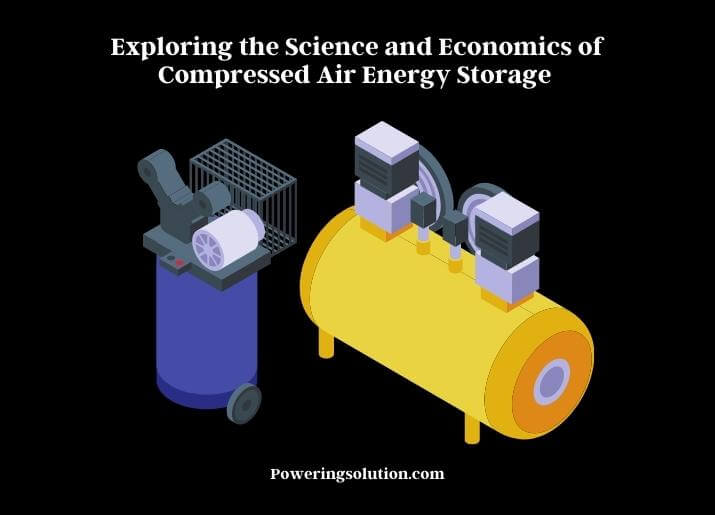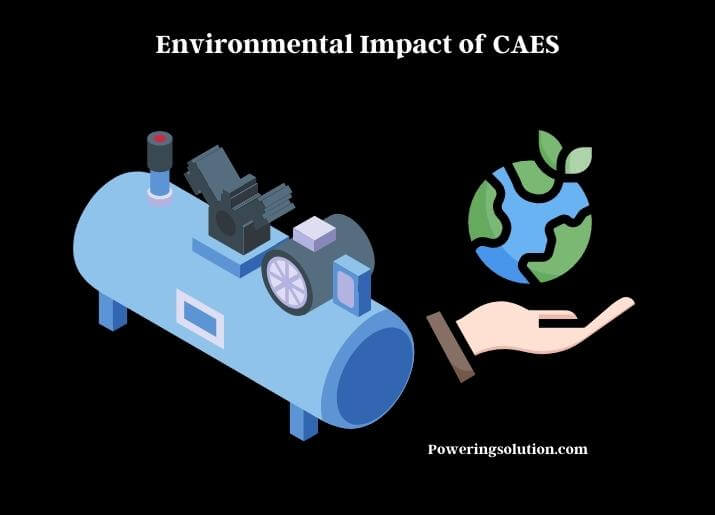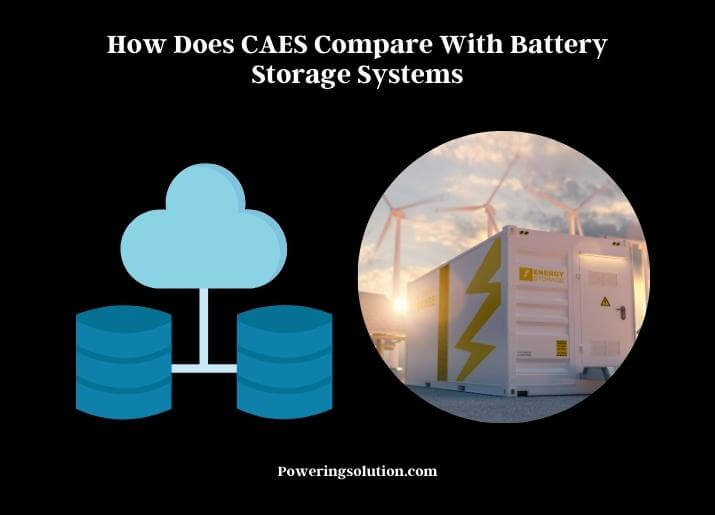Compressed Air Energy Storage (CAES) is an innovative energy storage technology that has gained significant attention in recent years. It is a form of energy storage that stores excess energy from the electrical grid in the form of compressed air in underground storage facilities. When there is a demand for energy, compressed air is released to generate electricity. This technology is gaining popularity as a solution to the intermittency of renewable energy sources such as solar and wind power.

CAES technology has been around for decades, but it has gained renewed interest in recent years due to the need for sustainable and reliable energy storage solutions. The first demonstration of the CAES system was carried out in Germany in 1978. Since then, several pilot projects and commercial-scale plants have been built around the world.
Compared to other energy storage technologies such as batteries, CAES has several advantages. It has a longer lifespan, lower maintenance costs, and can store much larger amounts of energy. However, it also has limitations, including its lower round-trip efficiency and the need for suitable geologic formations for underground storage.
How CAES Works?
CAES works by compressing and storing air in underground caverns or tanks when there is excess energy in the grid. When energy is required, the compressed air is released and expands through a turbine, generating electricity.
There are two main types of CAES: adiabatic and diabatic. In adiabatic CAES, the heat generated during compression is stored and reused during the expansion process. In diabatic CAES, the heat is released during compression and re-injected during the expansion process.
A typical CAES plant consists of four main components: the compressor, the storage facility, the expander, and the generator. The compressor compresses the air to a pressure of around 1000 psi and sends it to the underground storage facility. The storage facility can be a natural underground cavern or an artificially created tank. The cavern or tank needs to be lined with impermeable materials to prevent air leakage.
When energy is required, the compressed air is released from the storage facility and passed through a heat exchanger to warm it up before it is expanded through the turbine. The turbine is connected to a generator that produces electricity. The exhaust air is cooled and sent back to the underground storage facility.
The power generation process in CAES is flexible and can be adjusted to meet the grid’s demand. It can provide a constant source of electricity for several hours, making it suitable for balancing the fluctuations of renewable energy sources such as solar and wind power.
The compression and expansion processes in CAES involve the use of large amounts of energy, resulting in lower round-trip efficiency compared to other storage technologies such as batteries. However, the storage capacity of CAES can be much larger than that of batteries, making it more suitable for grid-scale energy storage.
The design and operation of CAES plants require careful consideration of several factors, including the geological and hydrological conditions of the storage site, the size of the plant, and the market conditions.
Advantages and Disadvantages of CAES
Advantages of CAES
- Large storage capacity: CAES can store large amounts of energy, making it suitable for grid-scale energy storage.
- Long lifespan: The lifespan of CAES is longer compared to other storage technologies such as batteries.
- Lower maintenance costs: The maintenance costs of CAES are relatively low compared to other storage technologies.
- Flexibility: CAES can provide a constant source of electricity for several hours, making it suitable for balancing the fluctuations of renewable energy sources such as solar and wind power.
- No emissions: CAES does not produce any emissions during operation, making it an environmentally friendly energy storage solution.
Disadvantages of CAES
- Lower round-trip efficiency: The compression and expansion processes in CAES involve the use of large amounts of energy, resulting in lower round-trip efficiency compared to other storage technologies such as batteries.
- Limited suitable storage sites: Suitable geologic formations are required for underground storage facilities, limiting the potential sites for CAES plants.
- Capital-intensive: The construction of CAES plants can be capital-intensive, making it less economically feasible in some areas.
- Noise pollution: The operation of CAES plants can produce noise pollution, affecting nearby communities.
- Environmental impact: The construction and operation of CAES plants can have some environmental impact, including land disturbance and potential air pollution from the compression process.
It is important to weigh the advantages and disadvantages of CAES to determine its suitability as a solution to the energy transition. The economic feasibility and environmental impact of CAES should be carefully considered in the planning and implementation of CAES projects.
Economic Feasibility of CAES
The economic feasibility of CAES depends on several factors, including the cost of electricity, the size of the plant, the location, and the market conditions. The capital cost of CAES plants is relatively high, but it can be offset by the long lifespan and low maintenance costs. The levelized cost of electricity (LCOE) is a commonly used metric to compare the cost of different energy technologies. The LCOE of CAES is generally higher than that of other storage technologies such as batteries, but it is competitive with other dispatchable power generation technologies such as natural gas power plants.

The market conditions also play a crucial role in the economic feasibility of CAES. The value of energy storage can vary depending on the market demand, the availability of renewable energy sources, and the regulatory framework. In some regions, CAES can provide ancillary services such as frequency regulation and capacity reserves, increasing its value in the energy market.
The location of CAES plants also affects their economic feasibility. Suitable geological formations for underground storage are required for CAES plants, limiting the potential sites for deployment. The proximity to the energy source and the grid connection also affects the economic feasibility of CAES plants.
In recent years, several countries have initiated programs to promote the deployment of CAES plants. For example, the US Department of Energy has provided funding for the research and development of CAES technology. The EU Horizon 2020 program has also funded several CAES projects. The deployment of CAES can contribute to the decarbonization of the energy sector and the transition to renewable energy sources.
The economic feasibility of CAES depends on several factors, and careful consideration of these factors is required in the planning and implementation of CAES projects. The potential benefits of CAES, including its large storage capacity and flexibility, should be weighed against its capital cost and limited suitable storage sites. The market conditions and regulatory framework also play a crucial role in the economic feasibility of CAES.
How Does CAES Compare With Battery Storage Systems?
Compressed Air Energy Storage (CAES) and battery storage systems are two popular options for energy storage. While both technologies provide a means of storing energy for later use, they differ in several ways.
One of the main differences between CAES and battery storage is their capacity and duration of discharge. CAES can typically store a larger amount of energy compared to battery storage systems, making it a better option for long-duration energy storage. Battery storage systems, on the other hand, have a faster response time and can discharge power more quickly, making them better suited for short-duration energy storage and providing ancillary services to the grid.

Another difference is their environmental impact. Battery storage systems use materials such as lithium, cobalt, and nickel, which can have significant environmental impacts during mining and processing. In contrast, CAES does not require the use of rare materials and has a lower environmental impact.
The cost is also an important factor in comparing CAES and battery storage systems. While CAES plants require significant capital investment and have higher upfront costs, they have lower operating costs and longer lifespans compared to battery storage systems. Battery storage systems, on the other hand, have lower upfront costs but require ongoing maintenance and replacement of batteries over time, leading to higher operating costs in the long run.
Environmental Impact of CAES
The construction and operation of CAES plants can have some environmental impact, including land disturbance and potential air pollution from the compression process. However, the environmental impact of CAES is generally lower compared to fossil fuel-based power generation technologies.
Land disturbance: The construction of underground storage facilities for CAES plants can result in land disturbance and habitat destruction. The size of the CAES plant and the location of the site are important factors in determining the extent of land disturbance.
Air pollution: The compression process in CAES plants involves the use of natural gas or other fossil fuels, resulting in potential air pollution. The emissions from the compression process can be reduced through the use of emission control technologies such as catalytic converters and filters. The use of renewable energy sources for the compression process can also reduce the environmental impact of CAES.
Water usage: The operation of CAES plants can require large amounts of water for cooling and other processes. However, the water usage of CAES plants is generally lower compared to other power generation technologies such as coal-fired power plants.
CAES Applications and Future Prospects
Renewable energy integration: CAES can help to integrate intermittent renewable energy sources such as wind and solar power into the grid by storing excess energy and releasing it during periods of high demand.
Peak shaving: CAES can be used to reduce peak demand on the grid by storing excess energy during off-peak hours and releasing it during periods of high demand.
Ancillary services: CAES can provide ancillary services such as frequency regulation and voltage control, improving the stability and reliability of the grid.
Backup power: CAES can provide backup power during power outages and other emergencies, improving the resiliency of the grid.
The future prospects of CAES are promising, with several new developments and initiatives underway:
Advancements in technology: Research and development efforts are ongoing to improve efficiency and reduce the cost of CAES technology. New materials and designs are being explored to enhance the performance of CAES plants.
Increased deployment: Several countries and regions are investing in CAES technology to meet their energy storage needs. The deployment of CAES is expected to increase significantly in the coming years.
Integration with renewable energy sources: CAES can play a key role in the integration of renewable energy sources into the grid. As the share of renewable energy sources in the energy mix increases, the demand for energy storage technologies such as CAES is expected to grow.
Policy support: Governments and regulatory agencies are implementing policies and incentives to support the deployment of CAES and other energy storage technologies. These policies are expected to promote the growth of the CAES market.
Can CAES be Used for Residential Energy Storage?
While CAES has several applications in the energy sector, it is not typically used for residential energy storage. CAES plants are large-scale facilities that require significant capital investment and specialized equipment to operate.
In contrast, residential energy storage systems are typically smaller in scale and designed for individual households. These systems may use batteries or other technologies to store energy generated by rooftop solar panels or other renewable energy sources.
While CAES may not be suitable for residential energy storage, it has the potential to play an important role in the integration of renewable energy sources into the grid and in meeting the energy storage needs of utilities and large industrial users.
Conclusion
Compressed Air Energy Storage (CAES) is an innovative technology that has the potential to play a significant role in the transition to a low-carbon energy system. CAES can provide several benefits, including energy storage for renewable energy sources, peak shaving, ancillary services, and backup power.
While CAES has some advantages and disadvantages, its economic feasibility and environmental impact make it a promising option for energy storage. The continued advancements in technology and increased deployment of CAES are expected to drive the growth of the market in the coming years.
Careful consideration should be given to the land disturbance and water usage associated with CAES projects to minimize their environmental impact. Governments and regulatory agencies can also play a key role in supporting the deployment of CAES and other energy storage technologies through policies and incentives.
CAES has the potential to contribute significantly to the development of a sustainable and reliable energy system. Its versatility and environmental friendliness make it a valuable option for energy storage and a promising technology for the future.
